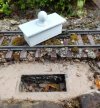You are using an out of date browser. It may not display this or other websites correctly.
You should upgrade or use an alternative browser.
You should upgrade or use an alternative browser.
Radio Control For Semaphore Signals
- Thread starter ge_rik
- Start date
ge_rik
British narrow gauge (esp. Southwold and W&LLR)
ThanksBrilliantly thought out
It's only taken me ten years to figure it out .....
To be fair, though, ten years ago, there weren't the miniature linear servos, the mini Seeeduino boards or the miniature receives linked to key fob transmitters that we now have. Without them, I was having to find waterproof ways of being able to plug each signal into a central loom.
Rik
ge_rik
British narrow gauge (esp. Southwold and W&LLR)
Could that have been Rat or Hedgehog poo? Pigeon tends to have some white in it.I've now produced plugs to fill the sockets when not in use, to try and prevent the sockets filling up with detritus.
View attachment 343792View attachment 343793
Talking of detritus - I only spotted the bird poo when I downloaded the photos from my camera. I'm not sure why pigeons especially seem to like using the track as a latrine.....
Rik
ge_rik
British narrow gauge (esp. Southwold and W&LLR)
Might well be. Not sure how to tell the difference - please don't tell me the easiest way is by taste .....Could that have been Rat or Hedgehog poo? Pigeon tends to have some white in it.
Rik
JimmyB
Now retired - trains and fishing
You do if you have fallen in the grass on the way homePigeon poo tends to fall from high, you don't tend to get hedgehog poo on the shoulder of your best jacket
There's always one!You do if you have fallen in the grass on the way home
ge_rik
British narrow gauge (esp. Southwold and W&LLR)
Hopefully, hedgehog. I spotted two the other evening hoovering up the bird food beneath the feeders.Could that have been Rat or Hedgehog poo? Pigeon tends to have some white in it.
Rik
ge_rik
British narrow gauge (esp. Southwold and W&LLR)
You've obviously never heard of the renowned Cheshire hedgehog aerobatics team.....Pigeon poo tends to fall from high, you don't tend to get hedgehog poo on the shoulder of your best jacket
Rik


